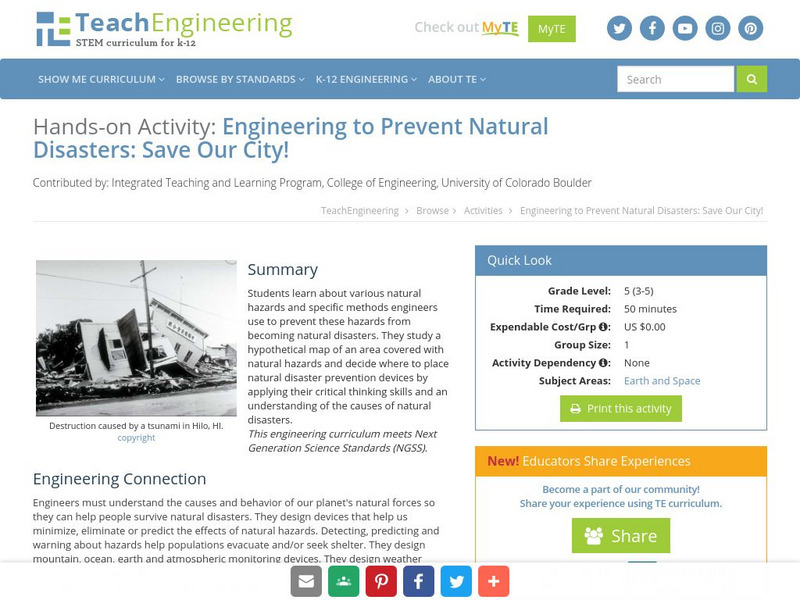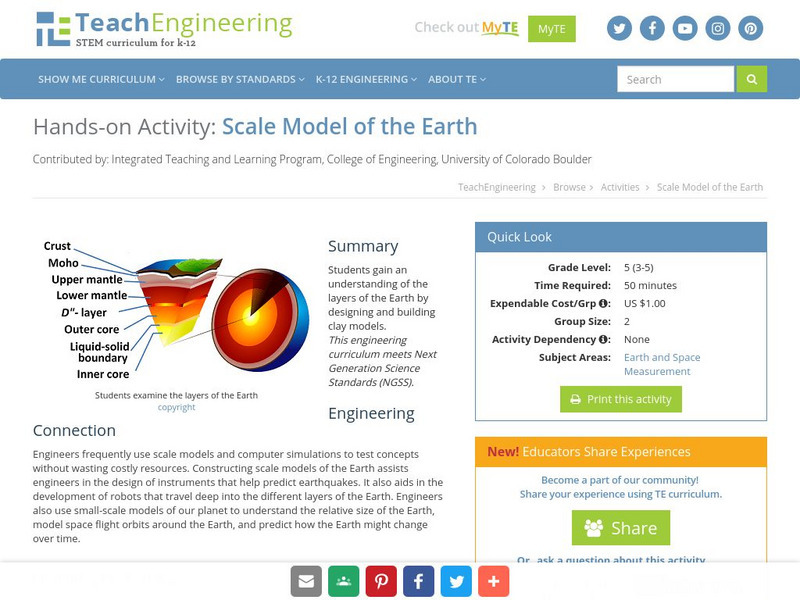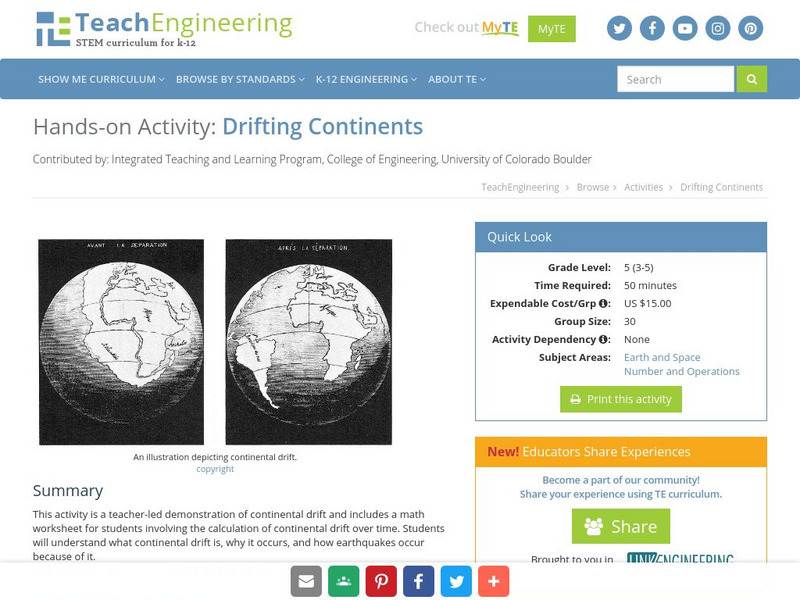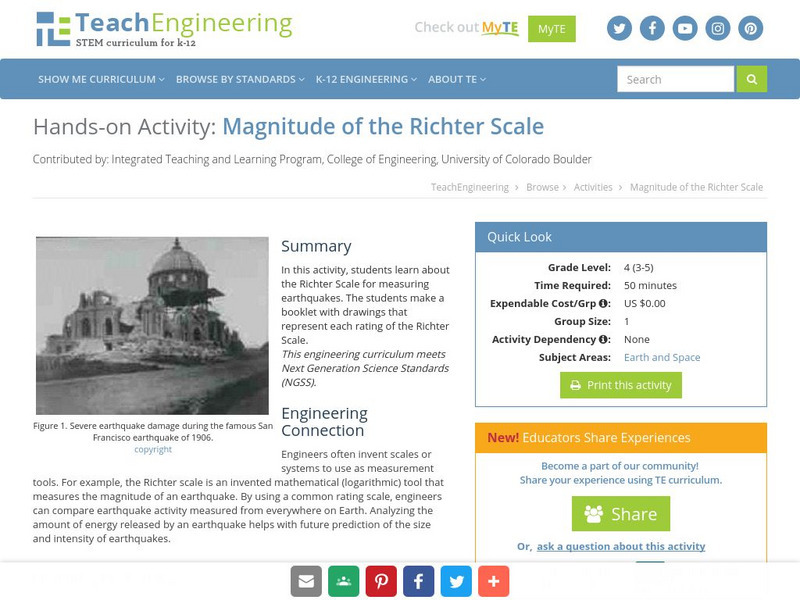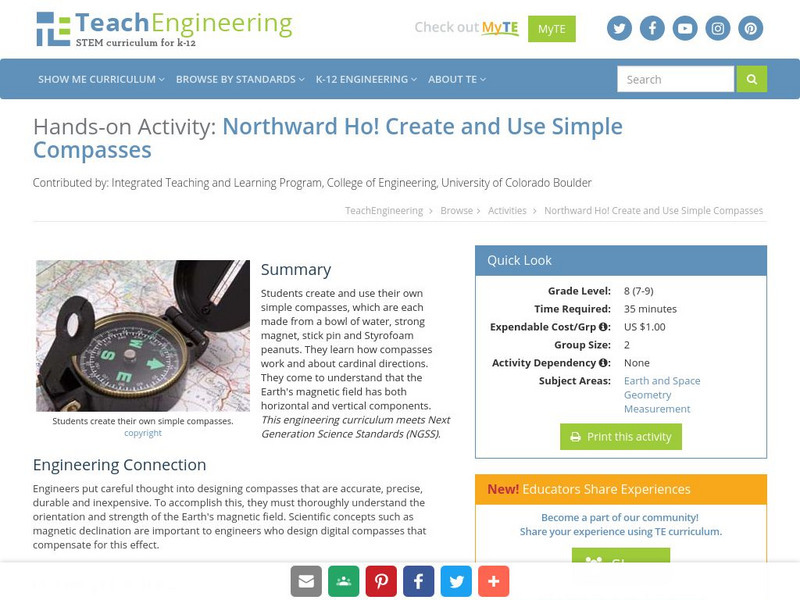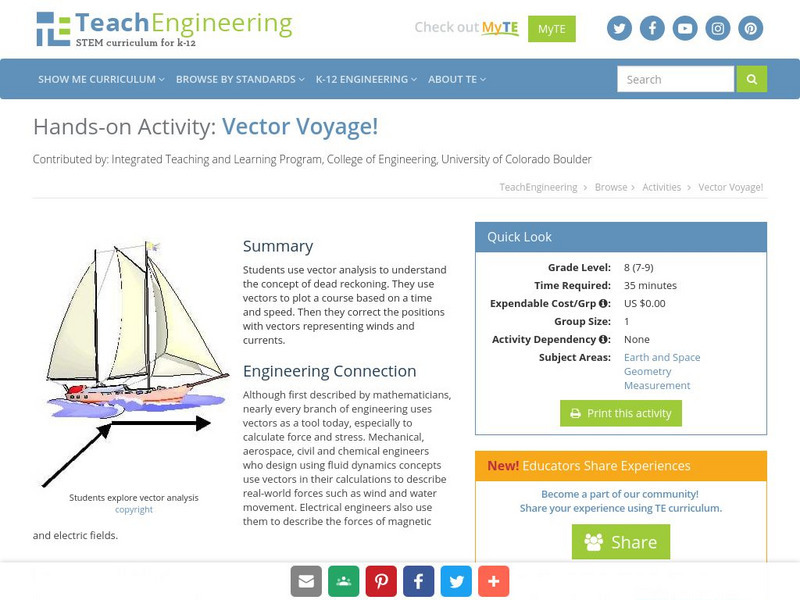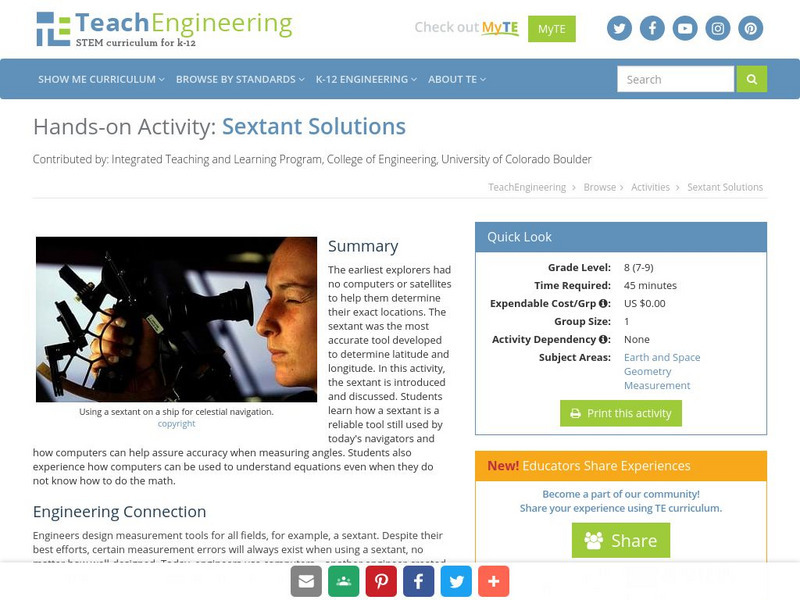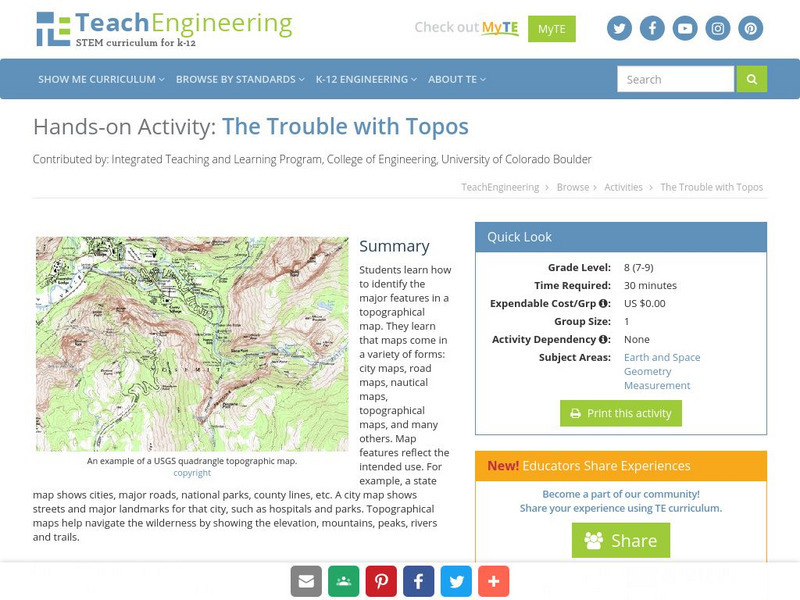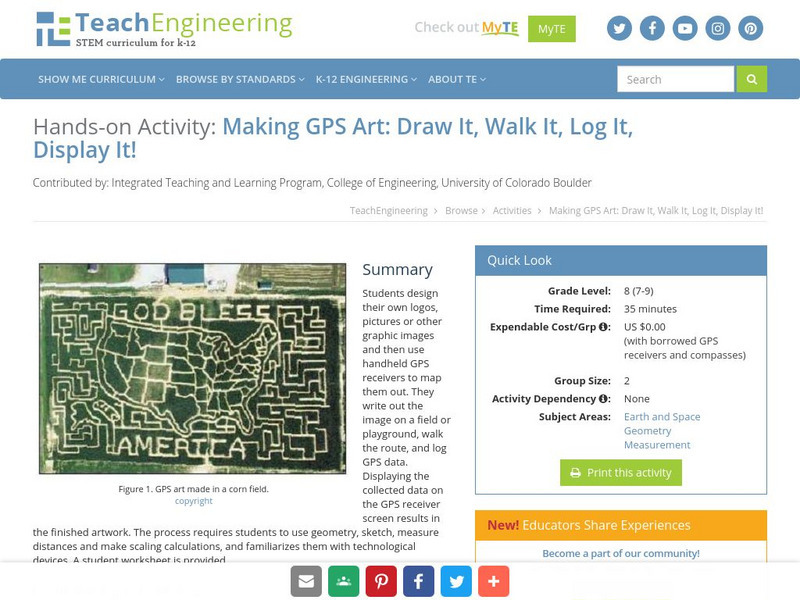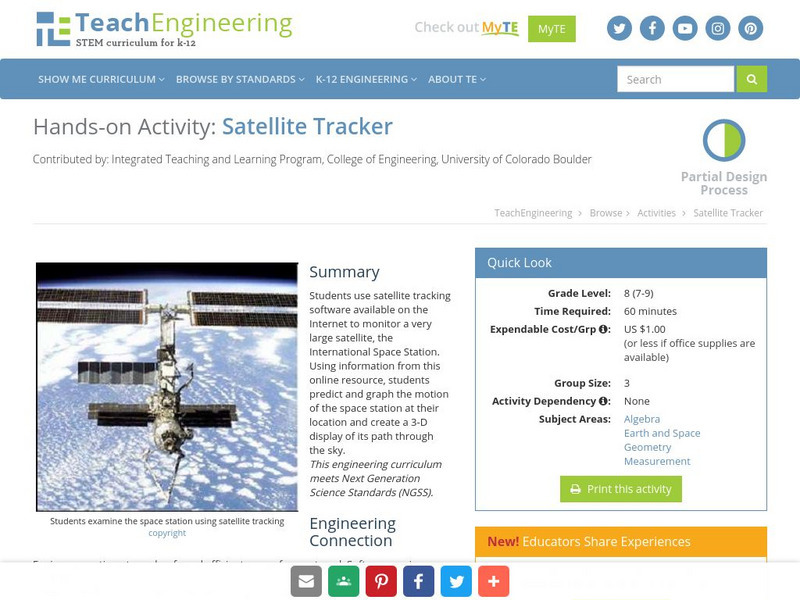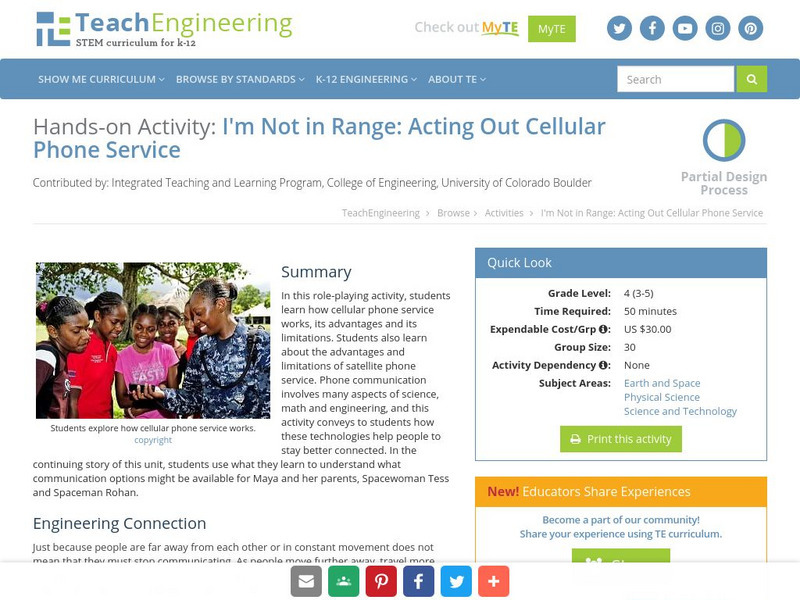TeachEngineering
Teach Engineering: Save Our City!
Students learn about various natural hazards and specific methods engineers use to prevent these hazards from becoming natural disasters. They study a hypothetical map of an area covered with natural hazards and decide where to place...
TeachEngineering
Teach Engineering: Scale Model of the Earth
In this activity, students gain an understanding of the layers of the Earth by designing and building a clay model.
TeachEngineering
Teach Engineering: Drifting Continents
This activity is a teacher-led demonstration of continental drift and includes a math worksheet for students involving the calculation of continental drift over time. Students will understand what continental drift is, why it occurs, and...
TeachEngineering
Teach Engineering: Faulty Movement
In this activity, students are introduced to faults. They will learn about different kinds of faults and understand their relationship to earthquakes. The students will build cardboard models of the three different types of faults as...
TeachEngineering
Teach Engineering: Mercalli Scale Illustrated
In this activity, students will learn about the Mercalli Scale for rating earthquakes. Also, students will make a booklet with drawings that represent each rating of the scale.
TeachEngineering
Teach Engineering: Magnitude of the Richter Scale
In this activity, students will learn about the Richter Scale for measuring earthquakes. The students will make a booklet with drawings that represent each rating of the Richter Scale.
TeachEngineering
Teach Engineering: Windstorm
In this activity, students will learn about how tornadoes are formed and what they look like. By creating a water vortex in a soda bottle, they will get a first-hand look at tornadoes.
TeachEngineering
Teach Engineering: Tornado Damage!
Students will learn about tornadoes, the damage they cause, and how to rate tornadoes. Specifically, students will investigate the Fujita Damage Scale of tornado intensity, and use it to complete a mock engineering analysis of damage...
TeachEngineering
Teach Engineering: Northward Ho!
In this activity, students will create their own simple compass, be able to explain how a compass works, understand that the Earth's magnetic field has both horizontal and vertical components, and learn more about cardinal directions.
TeachEngineering
Teach Engineering: Find Your Own Direction
In this activity, students create their own simple compass using thread, needle and water in a bowl - and learn how it works.
TeachEngineering
Teach Engineering: Vector Voyage!
In this activity, students will use vector analysis to understand the concept of dead reckoning. Students will use vectors to plot their course based on a time and speed. They will then correct the positions with vectors representing...
TeachEngineering
Teach Engineering: Sextant Solutions
The earliest explorers did not have computers or satellites to help them know their exact location. The most accurate tool developed was the sextant to determine latitude and longitude. In this activity, the sextant is introduced and...
TeachEngineering
Teach Engineering: Where Is Your Teacher?
In this activity, students will learn how to take bearing with a compass. They will also learn how to describe a bearing and find an object in their classroom using a bearing.
TeachEngineering
Teach Engineering: The Trouble With Topos
Students learn how to identify the major features in a topographical map. They learn that maps come in a variety of forms: city maps, road maps, nautical maps, topographical maps, and many others. Map features reflect the intended use....
TeachEngineering
Teach Engineering: Nautical Navigation
In this activity, students explore the importance of charts to navigation on bodies of water. Using one worksheet, students learn to read the major map features found on a real nautical chart. Using another worksheet, students draw their...
TeachEngineering
Teach Engineering: It's About Time
In past times, ocean navigators tossed a piece of wood over the side of their ships and noted how long until the ship passed the wood. They used this time measurement and the length of the ship to calculate their speed and estimate how...
TeachEngineering
Teach Engineering: Gps Receiver Basics
Students familiarize themselves - through trial and error - with the basics of GPS receiver operation. They view a receiver's satellite visibility screen as they walk in various directions and monitor their progress on the receiver's...
TeachEngineering
Teach Engineering: Gps Art
Students design their own logo or picture and use a handheld GPS receiver to map it out. They write out a word or graphic on a field or playground, walk the path, and log GPS data. The results display their "art" on their GPS receiver...
TeachEngineering
Teach Engineering: Gps Scavenger Hunt
Students go on a GPS scavenger hunt. They use GPS receivers to find designated waypoints and report back on what they found. They compute distances between waypoints based on the latitude and longitude, and compare with the distance the...
TeachEngineering
Teach Engineering: A Roundabout Way to Mars
Students explore orbit transfers and, specifically, Hohmann transfers. They investigate the orbits of Earth and Mars by using cardboard and string. Students learn about the planets' orbits around the sun, and about a transfer orbit from...
TeachEngineering
Teach Engineering: Satellite Tracker
Students use satellite tracking software available on the Internet to monitor a very large satellite, the International Space Station. Using information from this online resource, students predict and graph the motion of the space...
TeachEngineering
Teach Engineering: I'm Not in Range
In this role-playing activity, students learn how cellular phone service works, its advantages and its limitations. Students also learn about the advantages and limitations of satellite phone service. Phone communication involves many...
TeachEngineering
Teach Engineering: Newton Rocket Car
The purpose of this activity is to demonstrate Newton's third law of motion - which states that every action has an equal and opposite reaction - through a small wooden car. The Newton cars show how action/reaction works and how the mass...
TeachEngineering
Teach Engineering: Strawkets and Thrust
In this activity, students investigate the effect that thrust has on rocket flight. Students will make two paper rockets that they can launch themselves by blowing through a straw. These "strawkets" will differ in diameter, such that...


